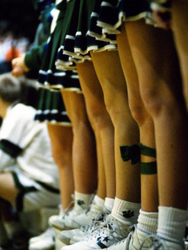What is the World’s Most Dangerous Sport?
(We Bet You’ll NEVER Guess)
by www.SixWise.com
Between 1982 and the spring of 2008, there were over 1,100 catastrophic injuries in high school and college sports, which includes any severe or fatal injury that occurred while participating in the sport.
|

Cheerleading can instill confidence, leadership and athletic ability into girls … yet its gymnastic-like stunts, coupled with lacking safety regulations, make it one of the most dangerous sports around.
|
Yet, a great portion of those injuries did not occur during a football, hockey, wrestling or any other type of contact sport, like you might suspect. They did not all occur during a baseball, soccer or basketball game either.
As it turns out, according to the National Center for Catastrophic Sports Injury Research at the University of North Carolina at Chapel Hill, which recently released its 26th annual report on the topic, the sport that causes more serious and deadly injuries among women than any other sport is … cheerleading.
In all, during the period spanning 1982 to spring 2008, there were 152 fatalities, 379 non-fatal injuries and 374 serious injuries among high school sports, and 22 fatalities, 63 non-fatal injuries and 126 serious injuries among college sports.
Of these, cheerleading accounted for a whopping 65 percent of high school, and 71 percent of college, catastrophic sports injuries among females.
"What's staggering, really, is that the single most dangerous activity in sports in schools is to be a flier [the person thrown into the air during a stunt] in cheerleading," Dr. Robert C. Cantu, clinical professor of neurosurgery at Boston University School of Medicine and chairman of Emerson Hospital's department of surgery, told The Boston Globe. "The chance for catastrophic injury is exponentially higher than for any other sports activity."
Why is Cheerleading So Dangerous?
Decades ago, cheerleading was largely made up of shaking pom-poms, catchy chants and dance moves. Today, cheerleading routines regularly involve tossing teammates 10-20 feet into the air, performing complicated flips and gymnastic moves.
Yet, although cheerleaders use a high level of athletic ability, cheerleading is still not considered a sport by the majority of schools.
|

Cheerleading accounted for a whopping 65 percent of high school, and 71 percent of college, catastrophic sports injuries among females from 1982-2008.
|
Because of this, it is not subject to the same safety regulations as other sports, like football. Meanwhile, cheerleading squads can exist without coaches or with coaches that have no safety certifications or training. Some schools also do not have the proper equipment or space for cheerleaders to practice safely.
"Modern cheerleading mostly closely resembles the sport of gymnastics, only without the mat and safety regulations," state Representative Peter J. Koutoujian, who filed a bill this year to create a committee to help make cheerleading less dangerous, said in The Boston Globe. "These are serious athletes that literally risk their necks to perform high-level stunts."
Is Cheerleading Getting Safer?
The obvious risks involved have not put a damper on cheerleading participation; there are an estimated 3 million cheerleaders in the United States alone. Fortunately, with participation growing the American Association of Cheerleading Coaches & Administrators (AACCA) points out that cheerleading safety standards are getting more stringent. They say:
- The NCAA’s insurance company, which used to have 25 percent of its claims coming from cheer injuries, has not had a catastrophic injury claim since 2006, when the NCAA started required coaches to get safety training.
- Emergency room visits among cheerleaders, which had been increasing every year, have leveled off in the last five years and even declined in some years, according to a National Electronic Injury Surveillance System survey by the Consumer Products Safety Commission.
- Currently, 13 states require training for its high school cheerleading coaches, and many more offer the AACCA safety course at coaches’ conferences.
- In 2006, AACCA banned basket tosses and 2 1/2 high pyramids from the basketball court for college cheerleading and basket tosses for high school (high school teams are already limited to two persons high for all skills).
- In 2008, AACCA restricted the use of twisting dismounts and other skills.
Five Important Cheerleading Safety Tips
If you are a parent with son or daughter in cheerleading, follow these tips to make sure he or she stays safe:
- Find out if the coach is qualified. Your child’s cheerleading coach should be certified by an organization like AACCA.
- Skills should be taught in the proper sequence. Skill progression training helps cheerleaders to master foundational skills before they move on to more advanced stunts. Spotters should also be used to help catch the top person in a stunt and protect their head, neck and shoulders.
- The practice space should be safe. Foam mats should be on the floor and stunts should not be performed on a basketball court or other hard surface.
- Make sure your child doesn’t go beyond their skill limit. Don’t allow your child to perform advanced gymnastics moves unless they have completed supplemental lessons at a certified gymnastics gym.
- Find out about the emergency plan. Your child’s cheerleading squad should have an emergency plan in place to help anyone who becomes injured. Talk to your coach about the plan, or insist they put one in place if they haven’t already.
Recommended Reading
Cheerleading: Becoming as Dangerous As These Top 7 Most Dangerous Youth Sports?
America's Favorite Sports and Favorite Sports Stars
Sources
Yahoo News June 26, 2009
National Center for Catastrophic Injury Research, Catastrophic Sport Injury Research 26th Annual Report
The Boston Globe April 19, 2009
American Association of Cheerleading Coaches & Administrators